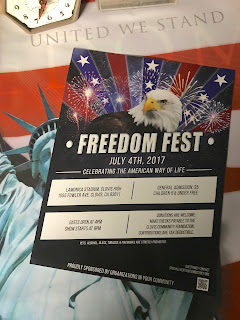Celebrate the adoption of the Declaration of Independence - Freedom Fest 2017
What's the point
of
Freedom Fest 2017?
Fireworks show!!!! Not quite, but it truly is a darn good show!
On 4th of July, every year in the United States, we celebrate the adoption of the Declaration of Independence. Yes, that's what we're doing on the 4th of July.
The positive impact that Freedom Fest 2017 will have in the community of Clovis, California is huge and cannot quickly be measured! Imagine thousands of Central California residents coming together to celebrate the American Way of Life, while building stronger community relationships with their fellow neighbors.
On this day a young person may be inspired to join the military? Maybe this will be the last time a grandson and grandfather will be able to physically spend 4th of July together? Whatever the outcome, Enriching lives is what it's all about.
Clovis Veterans Memorial District wants to give everyone in our community, military Veterans and their families another family friendly opportunity to gain great memories together.
The question is WHY do we do it?
Veterans Service
Organizations, Public Safety personnel, Volunteers, Surrounding small businesses and our community have chosen to make this year the most memorable Independence Day celebration ever seen in Clovis. We know how important it is to preserve our history. Below you can find a few more facts about the history of WHY we celebrate the 4th of July.
Please join us for Freedom Fest 2017!
Lamonica Stadium
Clovis, Ca / 5p - 10p
< DID YOU KNOW? >
Thomas Jefferson, the principal author of the Declaration
By Jefferson's own admission, the Declaration contained no original ideas, but was instead a statement of sentiments widely shared by supporters of the American Revolution. As he explained in 1825:
The sources and interpretation of the Declaration have been the subject of much scholarly inquiry.
1823 facsimile of the engrossed copy
Toward Independence!
Support for declaring independence grew even more when it was confirmed that King George had hired German mercenaries to use against his American subjects.
The Assembly Room in Philadelphia's Independence Hall, where the Second Continental Congress adopted the Declaration of Independence
Draft & Adoption
They removed Jefferson's assertion that Britain had forced slavery on the colonies in order to moderate the document and appease persons in Britain who supported the Revolution.
This idealized depiction was widely reprinted, of (left to right) Franklin, Adams, and Jefferson working on the Declaration
Women's suffrage and the Declaration
"All men and women are created equal"
Organized the the FIRST Woman's Rights Convention in Seneca Falls, New York, 1848.
Elizabeth Cady Stanton and her two sons (1848).
Portable writing desk that Jefferson used to draft and write the Declaration of Independence
Lincoln and the Declaration
During the seventh and last joint debate with Steven Douglas at Alton, Illinois on October 15, 1858, Lincoln said about the declaration:
Did you Know?...
The official copy of the Declaration of Independence was the one printed on July 4, 1776 under Jefferson's supervision. It was sent to the states and to the Army and was widely reprinted in newspapers. The slightly different "engrossed copy" was made later for members to sign. The engrossed version is the one widely distributed in the 21st century.
The Rotunda for the
Charters of Freedom
in the
National Archives building
After the publication came the reaction from the people...
Pulling Down the Statue of King George III, N.Y.C., ca. 1859, depicts citizens destroying a statue of King George after the Declaration was read in New York City on July 9, 1776.
The signed copy of the Declaration is now badly faded because of poor preserving practices in the 19th century. It is on display at the National Archives in Washington, D.C.
On July 4, 1776, Continental Congress President John Hancock's signature authenticated the United States Declaration of Independence.
Twentieth century and later
Presentation of the Declaration depicted on a United States postal issue of 1869
John Trumbull's famous painting is often identified as a depiction of the signing of the Declaration, but it actually shows the drafting committee presenting its work to the Congress.
"Declaration House", the boarding house at Market and S. 7th Street where Jefferson wrote the Declaration
After voting in favor of the resolution of independence, Congress turned its attention to the committee's draft of the declaration. Over several days of debate, they made a few changes in wording and deleted nearly a fourth of the text and, on July 4, 1776, the wording of the Declaration of Independence was approved and sent to the printer for publication.
The opening of the original printing of the Declaration, printed on July 4, 1776 under Jefferson's supervision. The engrossed copy was made later. Note that the opening lines differ between the two versions
signer of the Declaration of Independence, freed
his slave believing that he could not both
fight for liberty and own a slave.
In the postwar decades, other slaveholders also freed their slaves; from 1790 to 1810, the percentage of free blacks in the Upper South increased to 8.3 percent from less than one percent of the black population. All Northern states abolished slavery by 1804.
Bring the family to enjoy food, drinks, games, activities and top-shelf entertainment.
Basic information that you’ll need:
Time: Gates open at 5:00PM – Fireworks at Dusk
Cost: $5
Place: Clovis High School, Lamonica Stadium
*No pets, glass, fireworks, tobacco, alcohol, and loitering outside the stadium is Strictly Prohibited.
For information about the event and how to participate:
(559) 299-0471
specialevents@cvmdistrict.org
CVMD:
Reference: https://en.wikipedia.org/wiki/United_States_Declaration_of_Independence
Blog Sponsored by:
Clovis Veterans Memorial District
Blog by:
Fulton Film Company
#VeteranOwned





















Comments
Post a Comment